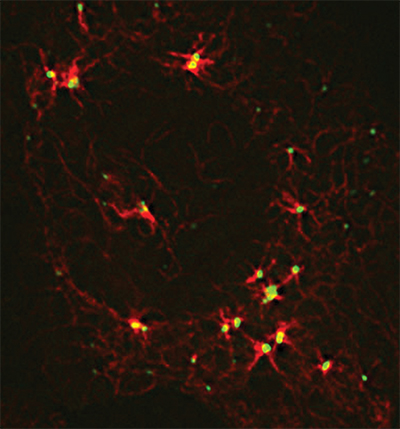JBC: A shadowy organizational hub in cells
On a cellular level, we are all hanging on by delicate threads. All cells are crisscrossed by a network of strands called microtubules, which act as railroad tracks that move cargo around the cell, as winch cables that separate chromosomes during cell division and as scaffolding components that give a cell its shape.
Because of its essential role in the cell cycle, microtubule assembly is the target of essential anti-cancer chemotherapies (paclitaxel, for example), which stop out-of-control cell division by destabilizing microtubules. Now, researchers have shed light on the role that a large, enigmatic protein plays in assembling microtubules, paving the way for better treatments. The results of the research in the Journal of Biological Chemistry.
 A large protein coordinates cellular components required for microtubule assembly.Courtesy of James Goldenring, Vanderbilt University
A large protein coordinates cellular components required for microtubule assembly.Courtesy of James Goldenring, Vanderbilt University
In 1999, research team at Vanderbilt University showed that protein kinase A-anchoring protein 350, or AKAP350, is a component of the centrosome, a center of microtubule organization in human cells. The team later showed that microtubules did not form efficiently without AKAP350. But the way in which AKAP350 regulated microtubule formation was difficult to understand, largely because of the technical challenges posed by AKAP350’s heft.
“Since this protein is so huge, it’s very difficult to study it,” said , the research scientist in Goldenring’s laboratory who led the new study. “A few years ago, we finally came to develop synthetic constructs of (AKAP350), which allowed us to go to the next level of evaluation and function.”
Using a combination of detailed biochemical analyses and super-resolution microscopy, the team finally was able to gain some understanding of the complex roles that AKAP350 plays in regulating microtubules in cells. AKAP350 formed a physical bridge spanning components of the centrosome. And AKAP350 appeared to recruit multiple proteins involved in building microtubules, coordinating their function in one spot.
“I like to call this thing Deep Space Nine. Everybody comes to hang out at AKAP350,” Goldenring said. “I think we’ve only scratched the surface of the structural organization that this protein is probably providing.”
Mutations in AKAP350 have been associated with cardiac arrhythmias, so it will be of interest to see whether the protein’s role in microtubule assembly contributes to proper heart function as well.
“I think (AKAP350) is a fundamental regulator of cell function,” Goldenring said. “So we need to know a lot more about this protein before we can even begin looking at what it might mean for disease.”
Enjoy reading ASBMB Today?
Become a member to receive the print edition four times a year and the digital edition monthly.
Learn moreGet the latest from ASBMB Today
Enter your email address, and we’ll send you a weekly email with recent articles, interviews and more.
Latest in Science
Science highlights or most popular articles

How scientists identified a new neuromuscular disease
NIH researchers discover Morimoto–Ryu–Malicdan syndrome, after finding shared symptoms and RFC4 gene variants in nine patients, offering hope for faster diagnosis and future treatments.

Unraveling cancer’s spaghetti proteins
MOSAIC scholar Katie Dunleavy investigates how Aurora kinase A shields oncogene c-MYC from degradation, using cutting-edge techniques to uncover new strategies targeting “undruggable” molecules.

How HCMV hijacks host cells — and beyond
Ileana Cristea, an ASBMB Breakthroughs webinar speaker, presented her research on how viruses reprogram cell structure and metabolism to enhance infection and how these mechanisms might link viral infections to cancer and other diseases.

Understanding the lipid link to gene expression in the nucleus
Ray Blind, an ASBMB Breakthroughs speaker, presented his research on how lipids and sugars in the cell nucleus are involved in signaling and gene expression and how these pathways could be targeted to identify therapeutics for diseases like cancer.

Receptor antagonist reduces age-related bone loss in mice
Receptor antagonist reduces bone loss and promotes osteoblast activity in aging mice, highlighting its potential to treat osteoporosis. Read more about this recent JBC paper.

Engineered fusion protein targets kiwifruit pathogen
Synthetic protein selectively kills kiwifruit pathogen, offering a promising biocontrol strategy for agriculture. Read more about this recent JBC paper.

.jpg?lang=en-US&width=300&height=300&ext=.jpg)